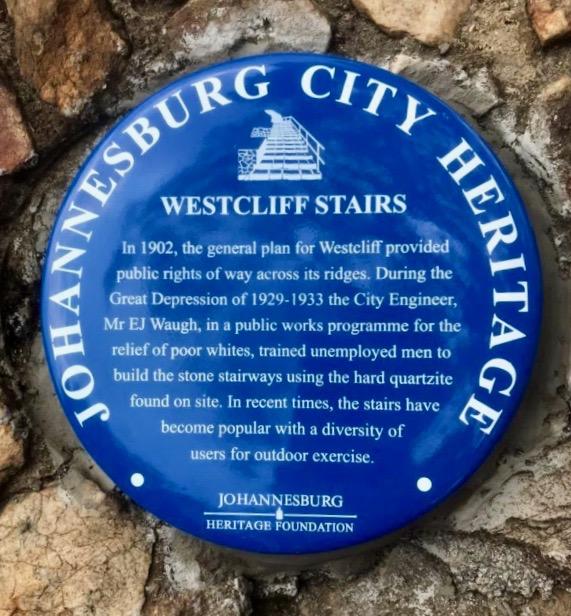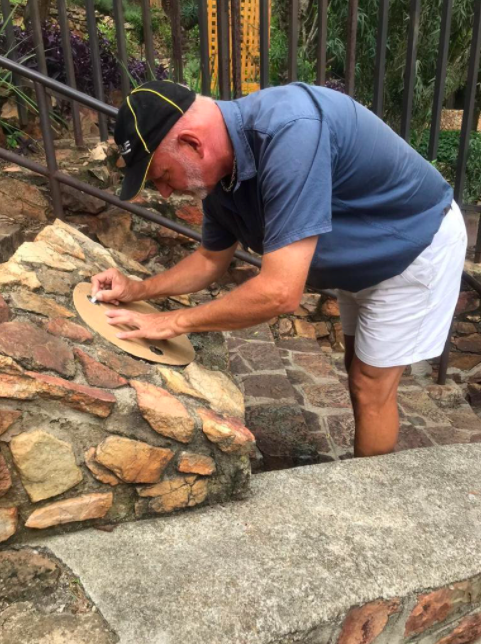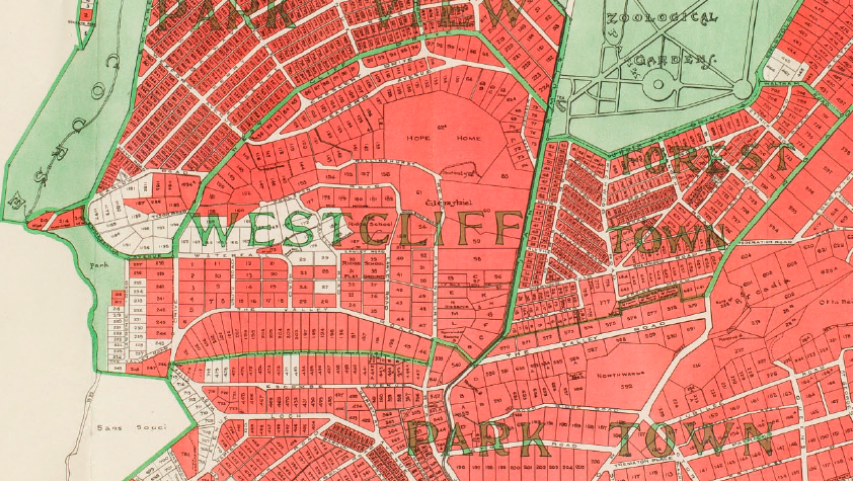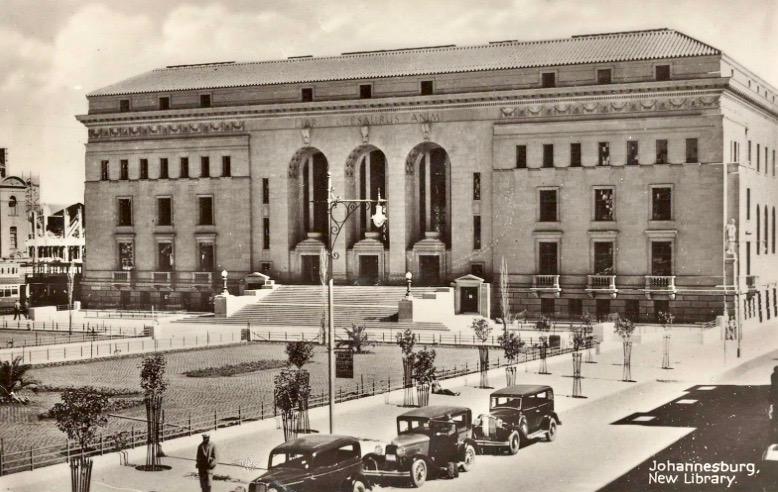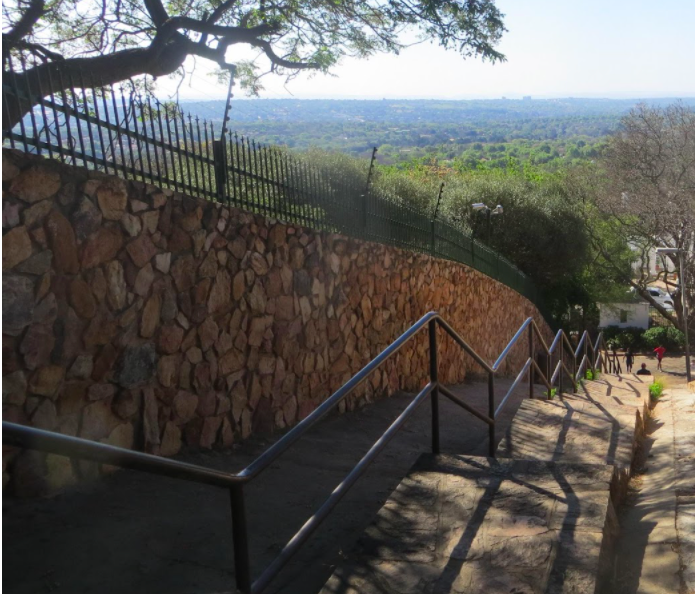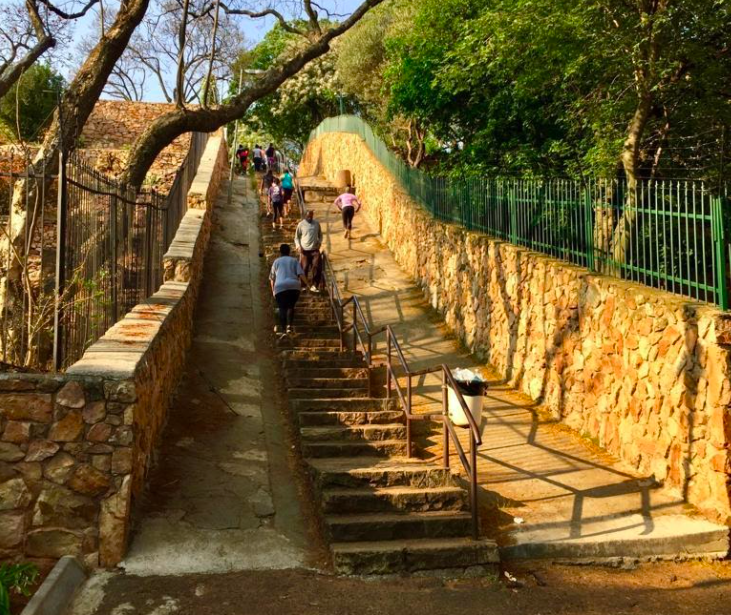
Disclaimer: Any views expressed by individuals and organisations are their own and do not in any way represent the views of The Heritage Portal. If you find any mistakes or historical inaccuracies, please contact the editor.
A cooperative effort of the City of Johannesburg, the Westcliff Residents Association and the Johannesburg Heritage Foundation decided to develop and place three blue plaques at strategic points on the stairs to mark the history. Today, the stairs offer an outdoor flight to heaven for athletic runners who come from all over the city to train and give themselves heart attacks! Residents and visitors co-exist.
Westcliff Stairs Blue Plaque (Kathy Munro)
In mid December 2021, two blue plaques were installed on the Westcliff Stairs. The third plaque will follow when a plinth has been constructed. The Westcliff Stairs are public rights of way that run through the suburb of Westcliff and are a feature of great pride to Westcliff property owners. The stairs are a drawcard for visitors and Johannesburg residents. October and November is a particularly popular time on the stairs as Westcliff is a riot of purple jacarandas.
Plaque installation (Kathy Munro)
The photograph below shows the Transvaal Consolidated Land and Exploration Company map of the seven suburbs developed by the Braamfontein Company and its successor body the TCL company. The seven suburbs are Park Town, Forest Town, Westcliff, Parkview, Parkwood, Saxonwold and Greenside. The map is undated but is circa 1932. The colours of the map are significant: green shows the open spaces of the Johannesburg Zoo, various parks and the Parkview Golf Course; the red shade shows the properties which have been purchased and are in private hands; the white portions are the still on the market and available for sale. It is interesting that the stands of Westcliff were not all sold when first marketed in the 1900s. At the start of the 20th century sales were sluggish and it was only between the wars that the suburb became attractive to a wider number of professional men for family homes. Bit by bit Forest Town, Parkview, and Westcliff were being developed.
Map of the seven suburbs developed by the Braamfontein Company
If you look carefully at this map you will notice a dark line showing a public right of way that has been in place since the original layout of the suburb; this marks the route which by that date had become the Westcliff Stairs. The first set of stairs can be found between Wexford Road (between 28 and 26 Wexford Road) and Pallinghurst Road. The second, shorter set can be found between Pallinghurst Road and Woolston Road. A third set of lesser-known stairs is found between the homes of Woolston Road leading back down onto Westlcliff Drive.
The History of the Stairs
In the Depression years, the City of Johannesburg’s City Engineer, E H Waugh developed a public works programme to employ and train unemployed men to cut stones, heave them up or down the hill and cement them into place to create a public path. In line with thinking of the time and in the context of the inward migration of poor rural people to the city, many of whom were Afrikaners, the government’s national public works programme concentrated on providing jobs for unskilled poor whites. What was called “a civilized labour policy” was clamped to a nationalistic tariff protection programme offering companies in specific industries the carrots of higher duties imposed on competitor imported products if these industries employed the unemployed whites – of course at higher wage rates than would have been paid to black workers. Government building projects worked on a basis of reserving job positions and government subsidized the wages of these workers. It was social engineering that interfered in market trends.
The city followed suit with a public works programme and hence there are a number of city developments that fit into this period: the stairs over the ridges (there is also a similar set of stairs in Brixton) and the construction of Stewart Drive linking Bertrams to Yeoville. It was an impressive achievement and an interesting example of social engineering to address social problems.
Stewart Drive (The Heritage Portal)
Waugh, who came to Johannesburg from Australia just after the Boer War and worked for the Johannesburg Council from 1902, oversaw a wide range of city projects. During his term of office the Bruma and Cydna sewerage works were commissioned, attractive stone bridges were built (the Gleneagles Bridge and the Parkhurst Bridge), Clarendon Circle was designed, an architectural competition for the layout of Orlando as a model black garden suburb was initiated, and a new Central Fire Station and the Johannesburg Public library were built. He was also the man responsible for the construction of the Crematorium at the Braamfontein Cemetery.
Johannesburg Public Library
Johannesburg Crematorium (South African Builder Magazine)
The plaques commemorating the Westcliff Stairs are a majot achievement and the organisations involved must be applauded for their effots.
The historic stairs from above (Kathy Munro)
References and further reading
- Anna Smith. Johannesburg Street Names. Juta. 1972
- E M Macphail. The Story of Westcliff. Palala Press. 1986
- A P Cartwright. The Corner House. The Early History of Johannesburg. Purnell. 1965
- A P Cartwright. Golden Age- The Story of industrialization of South Africa and the part played in it by the Corner House group of company 1910-1967. Purnell & Son. 1968
- Clive Chipkin. Johannesburg Style Architecture and Society 1880s – 1960s. David Philip. 1993
- Clive Chipkin. Johannesburg Transition. Architecture and Society from 1950. STE Publishers. 2009
- Barlow Rand Archives. When located at Barlow Park, Sandton. No longer accessible. Archive now at the University of the Witwatersrand
- Daphne Saul and Flo Bird. The Braamfontein Company: Developing Parktown no 25 of the Parktown Collection published by the Parktown & Westcliff Heritage Trust
- Holmden’s Register of the Townships Maps of Johannesburg and District no date, circa 1923 to 1950 - map of Westcliff
Acknowledgement to Danie Smit, JHF Blue plaque installer. Grateful thanks to Archie Barnwell for photographs of his walks through Westcliff.
Kathy Munro is an Honorary Associate Professor in the School of Architecture and Planning at the University of the Witwatersrand. She enjoyed a long career as an academic and in management at Wits University. She trained as an economic historian. She is an enthusiastic book person and has built her own somewhat eclectic book collection over 40 years. Her interests cover Africana, Johannesburg history, history, art history, travel, business and banking histories. She researches and writes on historical architecture and heritage matters. She is a member of the Board of the Johannesburg Heritage Foundation and is a docent at the Wits Arts Museum. She is currently working on a couple of projects on Johannesburg architects and is researching South African architects, war cemeteries and memorials. Kathy is a member of the online book community the Library thing and recommends this cataloging website and worldwide network as a book lover's haven. She is also the Chairperson of HASA.
Comments will load below. If for any reason none appear click here for some troubleshooting tips. If you would like to post a comment and need instructions click here.

